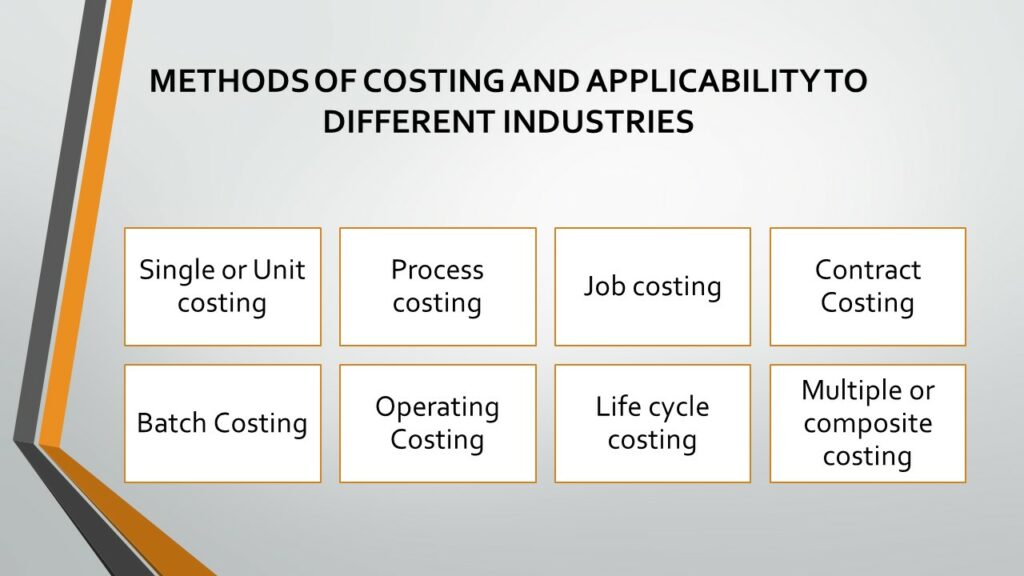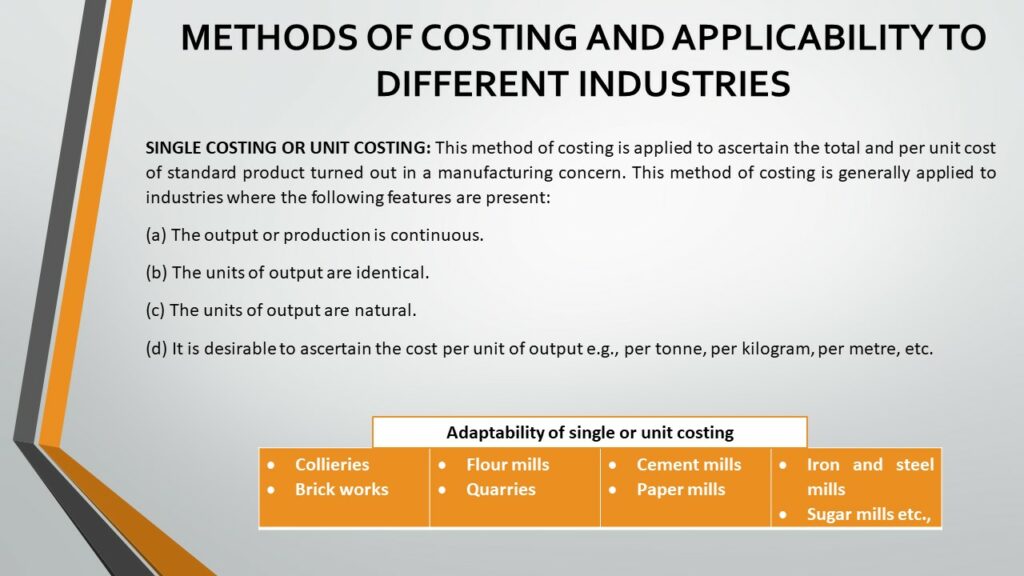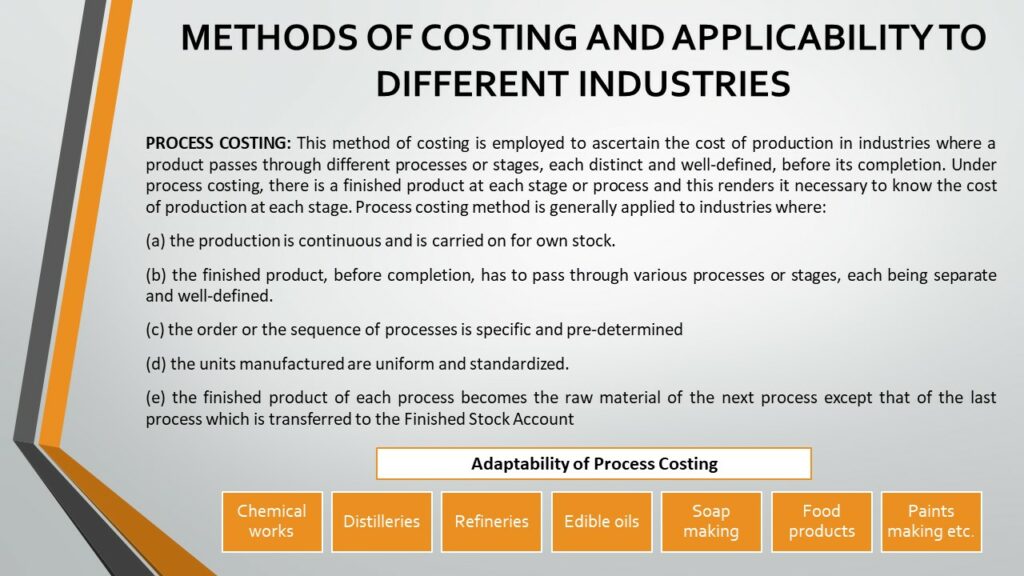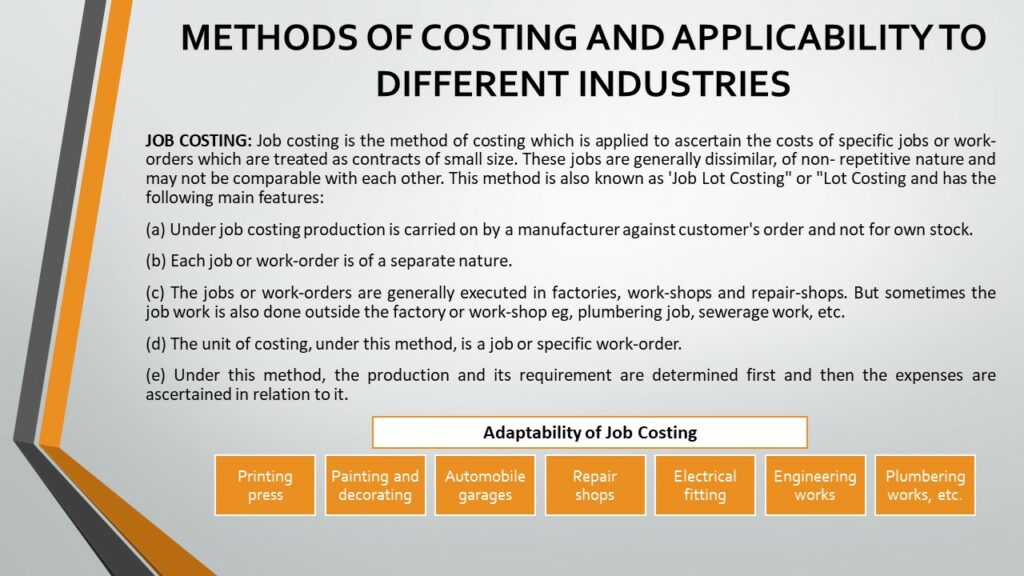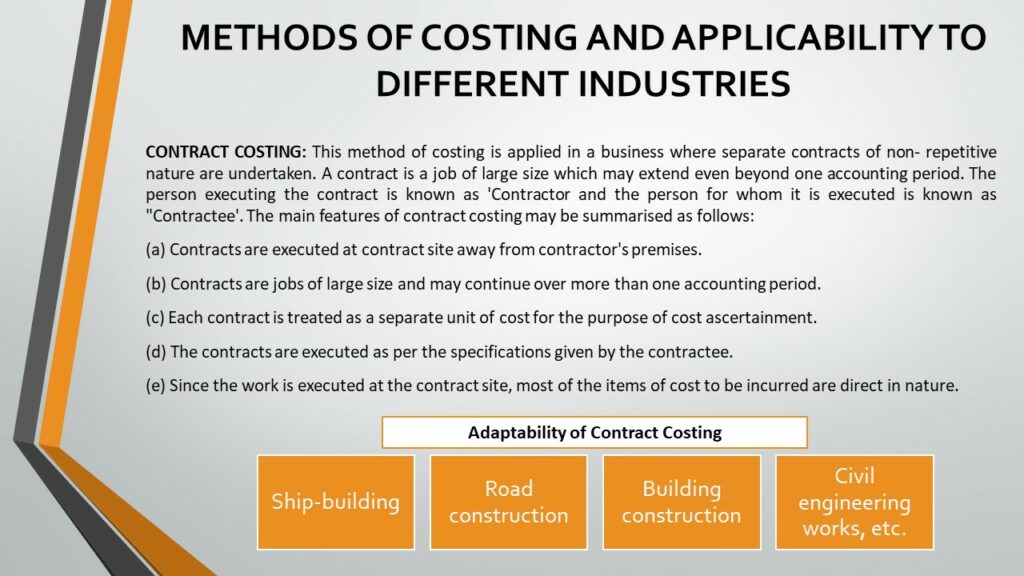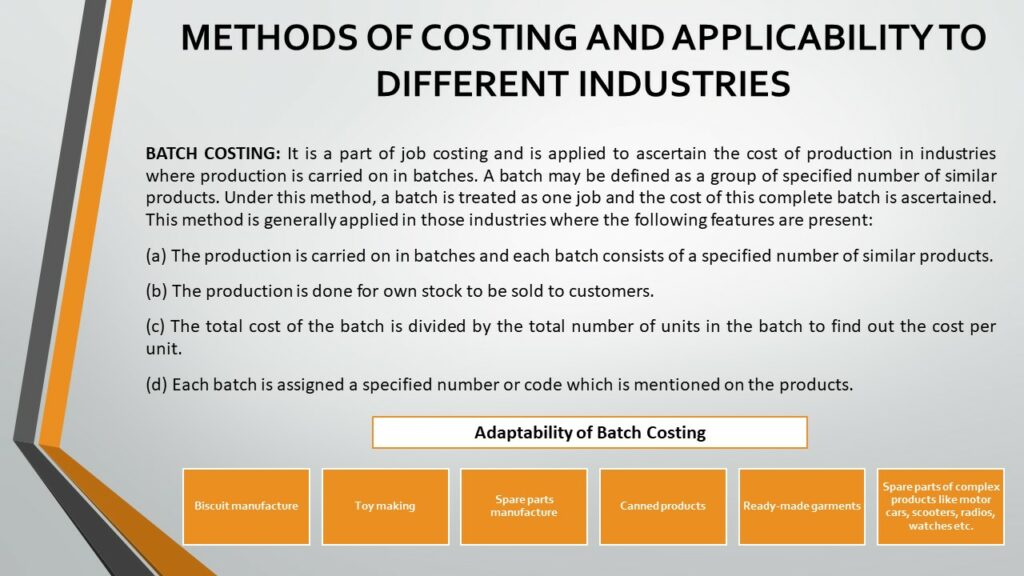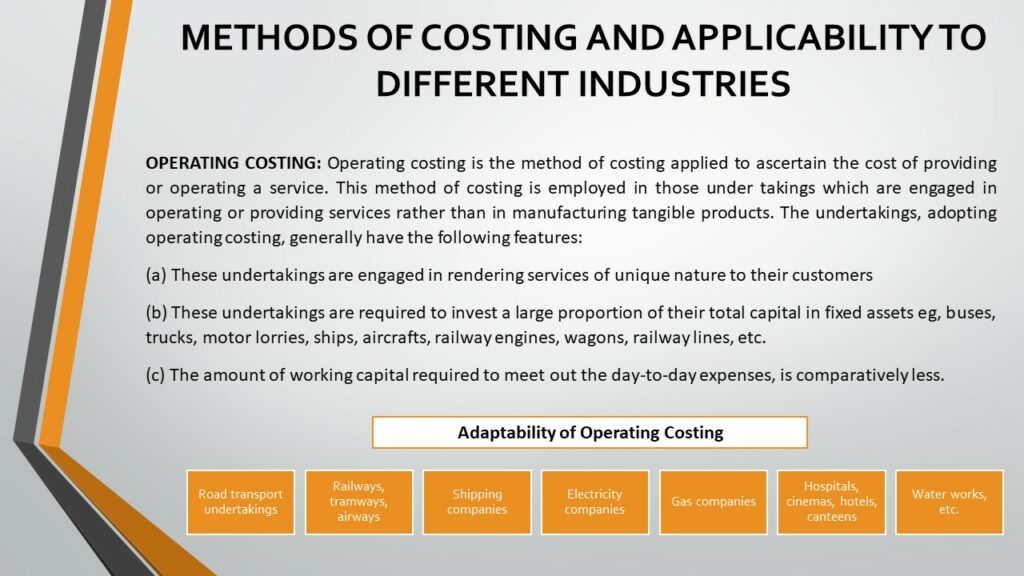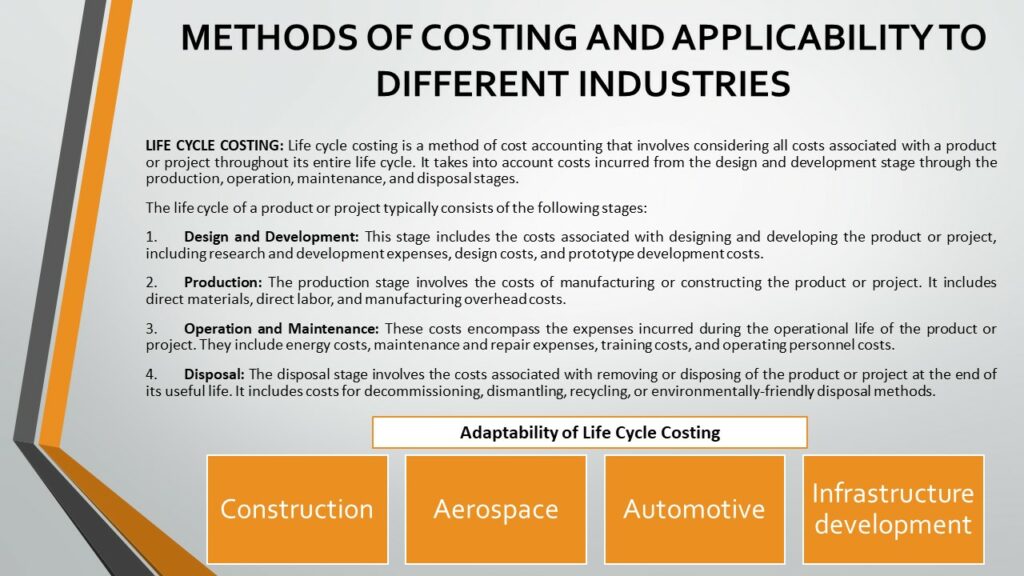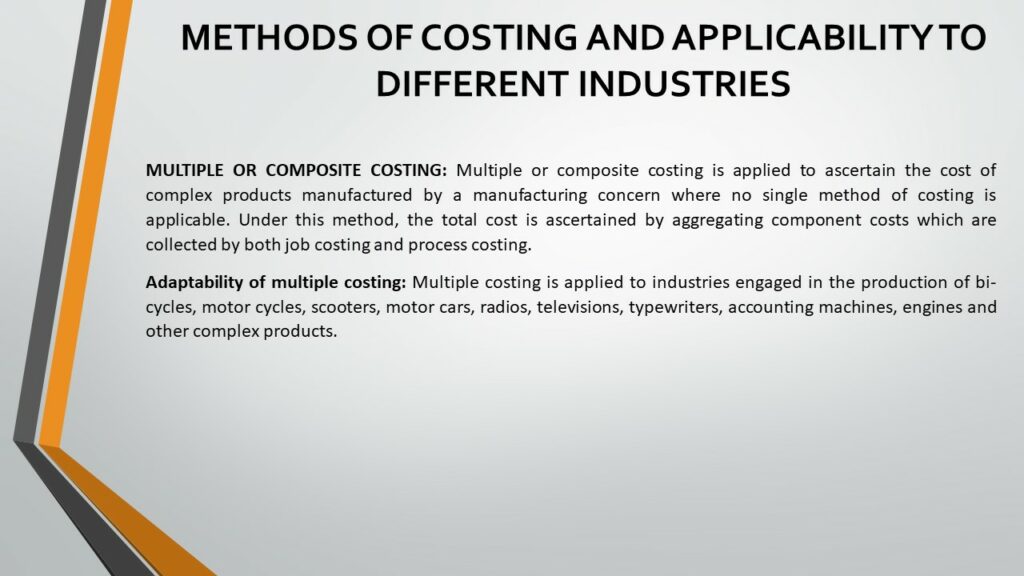Methods of Cost Accounting and their Adaptability in different industries
Different methods of costing are applied for ascertaining unit cost in different industries based on the nature of operation and unit of finished product involved.
Basically, there are two methods of costing viz., Job Costing and Process Costing.

Job costing is applied to special order type of industry which is devoted to the execution of specific orders such as printing press, ship building house building, road construction, bridge construction, etc., The main object of job costing is to ascertain the cost and profit or loss in respect of each job, contract or project undertaken.
Process costing is applied to mass production type of industry engaged in the continuous production of uniform standard products such as chemicals, oil, cement, cloth, yarn, mining, colliery, etc. The main object of process costing is to ascertain the cost of process or operation involved in converting raw materials into finished products.
The different methods of costing, which represent finer divisions of these two basic methods, may be enumerated as follows:
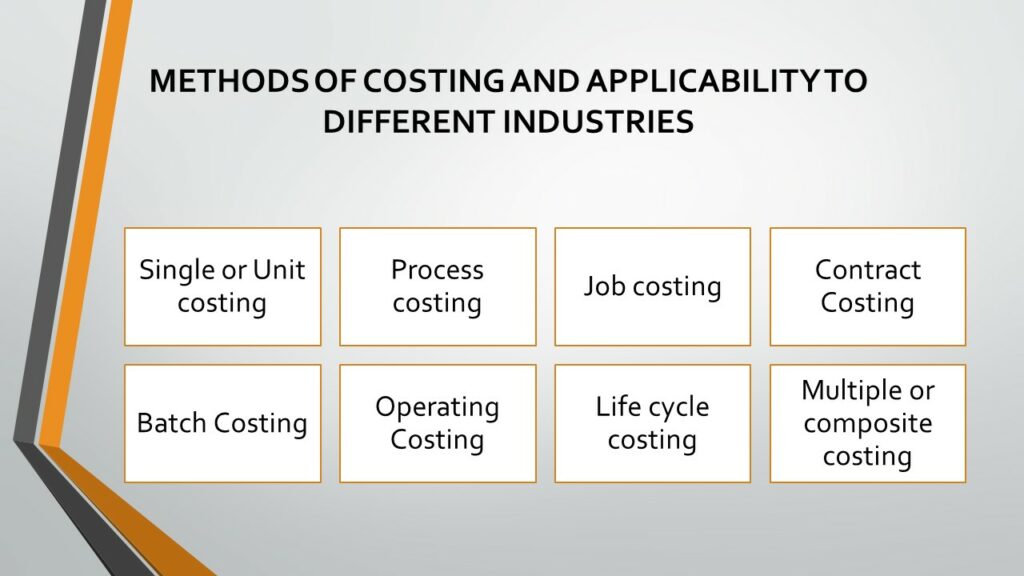
1. SINGLE COSTING OR UNIT COSTING: This method of costing is applied to ascertain the total and per unit cost of standard product turned out in a manufacturing concern. This method of costing is generally applied to industries where the following features are present:
(a) The output or production is continuous.
(b) The units of output are identical.
(c) The units of output are natural.
(d) It is desirable to ascertain the cost per unit of output e.g., per tonne, per kilogram, per metre, etc.
Adaptability of single or unit costing: Unit costing is used in industries like
- Collieries
- Brick works
- Flour mills
- Quarries
- Cement mills
- Paper mills
- Iron and steel mills
- Sugar mills etc.,
which are engaged in producing only one type of product or a few grades of the same product.
2. PROCESS COSTING: This method of costing is employed to ascertain the cost of production in industries where a product passes through different processes or stages, each distinct and well-defined, before its completion. Under process costing, there is a finished product at each stage or process and this renders it necessary to know the cost of production at each stage. Process costing method is generally applied to industries where:
(a) the production is continuous and is carried on for own stock.
(b) the finished product, before completion, has to pass through various processes or stages, each being separate and well-defined.
(c) the order or the sequence of processes is specific and pre-determined
(d) the units manufactured are uniform and standardised.
(e) the finished product of each process becomes the raw material of the next process except that of the last process which is transferred to the Finished Stock Account
Adaptability of Process Costing: This method is generally employed in industries like
- Chemical works
- Distilleries
- Refineries
- Edible oils
- Soap making
- Food products
- Paints making etc.
Under this method, a separate account is opened for each process and costing information is presented in the form of Process Account which is debited with the costs incurred thereon.
3. JOB COSTING: Job costing is the method of costing which is applied to ascertain the costs of specific jobs or work-orders which are treated as contracts of small size. These jobs are generally dissimilar, of non- repetitive nature and may not be comparable with each other. This method is also known as ‘Job Lot Costing” or “Lot Costing and has the following main features:
(a) Under job costing production is carried on by a manufacturer against customer’s order and not for own stock.
(b) Each job or work-order is of a separate nature.
(c) The jobs or work-orders are generally executed in factories, work-shops and repair-shops. But sometimes the job work is also done outside the factory or work-shop eg, plumbering job, sewerage work, etc.
(d) The unit of costing, under this method, is a job or specific work-order.
(e) Under this method, the production and its requirement are determined first and then the expenses are ascertained in relation to it.
Adaptability of Job Costing: Job costing method is most suitable to industries such as
- Printing press
- Painting and decorating
- Automobile garages
- Repair shops
- Electrical fitting
- Engineering works
- Plumbering works, etc.
where work is done according to the customer’s specifications.
4. CONTRACT COSTING: This method of costing is applied in a business where separate contracts of non- repetitive nature are undertaken. A contract is a job of large size which may extend even beyond one accounting period. The person executing the contract is known as ‘Contractor and the person for whom it is executed is known as “Contractee’. The main features of contract costing may be summarised as follows:
(a) Contracts are executed at contract site away from contractor’s premises.
(b) Contracts are jobs of large size and may continue over more than one accounting period.
(c) Each contract is treated as a separate unit of cost for the purpose of cost ascertainment.
(d) The contracts are executed as per the specifications given by the contractee.
(e) Since the work is executed at the contract site, most of the items of cost to be incurred are direct in nature.
Adaptability of contract costing: Contract costing is most suitable to
- Ship-building
- Road construction
- Building construction
- Civil engineering works, etc.
5. BATCH COSTING: It is a part of job costing and is applied to ascertain the cost of production in industries where production is carried on in batches. A batch may be defined as a group of specified number of similar products. Under this method, a batch is treated as one job and the cost of this complete batch is ascertained. This method is generally applied in those industries where the following features are present:
(a) The production is carried on in batches and each batch consists of a specified number of similar products.
(b) The production is done for own stock to be sold to customers.
(c) The total cost of the batch is divided by the total number of units in the batch to find out the cost per unit.
(d) Each batch is assigned a specified number or code which is mentioned on the products.
Adaptability of Batch Costing: Batch costing is generally employed in industries engaged in
- Biscuit manufacture
- Toy making
- Spare parts manufacture
- Canned products
- Ready-made garments
- Spare parts of complex products like motor cars, scooters, radios, watches etc.
6. OPERATING COSTING: Operating costing is the method of costing applied to ascertain the cost of providing or operating a service. This method of costing is employed in those under takings which are engaged in operating or providing services rather than in manufacturing tangible products. The undertakings, adopting operating costing, generally have the following features:
(a) These undertakings are engaged in rendering services of unique nature to their customers
(b) These undertakings are required to invest a large proportion of their total capital in fixed assets eg, buses, trucks, motor lorries, ships, aircrafts, railway engines, wagons, railway lines, etc.
(c) The amount of working capital required to meet out the day-to-day expenses, is comparatively less.
Adaptability of Operating Costing: This method is applicable to industries such as
- Road transport undertakings
- Railways, tramways, airways
- Shipping companies
- Electricity companies
- Gas companies
- Hospitals, cinemas, hotels, canteens
- Water works, etc.
The presentation of costing information is made in the form of a statement known as “Operating Cost Sheet.”
7. LIFE CYCLE COSTING: Life cycle costing is a method of cost accounting that involves considering all costs associated with a product or project throughout its entire life cycle. It takes into account costs incurred from the design and development stage through the production, operation, maintenance, and disposal stages.
The life cycle of a product or project typically consists of the following stages:
- Design and Development: This stage includes the costs associated with designing and developing the product or project, including research and development expenses, design costs, and prototype development costs.
- Production: The production stage involves the costs of manufacturing or constructing the product or project. It includes direct materials, direct labor, and manufacturing overhead costs.
- Operation and Maintenance: These costs encompass the expenses incurred during the operational life of the product or project. They include energy costs, maintenance and repair expenses, training costs, and operating personnel costs.
- Disposal: The disposal stage involves the costs associated with removing or disposing of the product or project at the end of its useful life. It includes costs for decommissioning, dismantling, recycling, or environmentally-friendly disposal methods.
Adaptability of life cycle costing: Life cycle costing considers costs incurred over the entire lifespan of a product or project. It is applicable in industries such as
- Construction
- Aerospace
- Automotive
- Infrastructure development
where products or projects have long lifecycles.
8. MULTIPLE OR COMPOSITE COSTING: Multiple or composite costing is applied to ascertain the cost of complex products manufactured by a manufacturing concern where no single method of costing is applicable. Under this method, the total cost is ascertained by aggregating component costs which are collected by both job costing and process costing.
Adaptability of multiple costing: Multiple costing is applied to industries engaged in the production of bi-cycles, motor cycles, scooters, motor cars, radios, televisions, typewriters, accounting machines, engines and other complex products.

